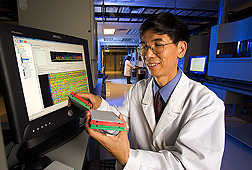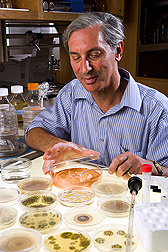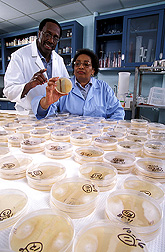Killer Fungi
They’re odorless. Invisible. Nature’s most potent poisons. Yet you’ve probably never heard of them.
“Mycotoxins,” as they’re known, are highly carcinogenic compounds produced by certain species of Aspergillus and Fusarium fungi. Given the right cues, these normally subdued fungal soil dwellers can rise up against their plant hosts and overrun farm fields. Spewing out toxins, the fungi can turn vulnerable crops—like corn, peanuts, almonds, and cottonseed—into little more than toxic mush.
In the drought years of 1983 and 1988, for instance, mycotoxins cost Midwest corn growers more than $280 million. In the developing world, costs associated with mycotoxins are much higher: Contaminated crops jeopardize human health and food security.
While the public may just be learning about these poisons, they’ve long been a target of ARS scientists. This cadre of researchers—with laboratories in New Orleans, Louisiana; Athens, Georgia; Peoria, Illinois; and Albany, California—makes up the largest mycotoxin-fighting task force in the country. And it’s tackling these vicious molds from every possible vantage.
|
|
A Colorful Past
ARS plant pathologist Ed Cleveland, who heads up the Food and Feed Safety Research Unit of the agency’s Southern Regional Research Center (SRRC) in New Orleans, is one scientist who’s trying to demystify these potentially deadly molds—which still hold many secrets.
For one thing, researchers don’t know exactly why the fungi produce toxins. “The toxins may offer the fungi some kind of ecological advantage over other microbes—we’re not sure,” he says. “We do know that they possess a large cluster of genes devoted specifically to toxin production.”
One mycotoxin that ARS researchers are keenly interested in is aflatoxin—named for the A. flavus fungus that makes it. SRRC chemist Kenneth Ehrlich suggests that aflatoxin production may have arisen by accident. He’s found that several Aspergillus ancestors possessed the genetic machinery to churn out precursors to aflatoxin, but that these compounds were not lethal.
|
|
“In fact,” says Ehrlich, “the compounds are really quite beautiful, occurring in shades of bright-red, yellow, and brown. It’s possible that insects may have been attracted to the vivid pigments, just as they are to flowers. As a result, the fungi would have gotten to hitch free rides all around the world, courtesy of the insects.” But somewhere along the way, Ehrlich thinks, the fungi suddenly found themselves in a more hostile environment—one that necessitated expanding their chemical repertoire to include more defensive (that is, poisonous) products.
Equally puzzling is that while some Aspergillus species churn out lots of aflatoxin, many don’t make it at all. While A. flavus is a prolific toxin producer, its close relative, A. oryzae, is not only nontoxic, it’s also used to make soy sauce.
So, what allows these two fungal cousins—which might be considered the Jekyll and Hyde of Aspergillus species—to be so alike, and yet so fundamentally different? “We’re getting closer to answering that question,” says Cleveland, who points to recent findings by SRRC geneticist Jiujiang Yu and others in his research unit.
Solving a Mystery, Through Genes
Yu, with collaborators Gary Payne at North Carolina State University-Raleigh and Bill Nierman at the Institute for Genomic Research (TIGR) in Rockville, Maryland, recently sequenced the A. flavus genome—creating, for the first time, a true genetic blueprint of the organism. Before that, Yu, Cleveland, Deepak Bhatnagar, and other SRRC researchers helped Japanese scientists sequence all the genes belonging to A. oryzae, the food-grade fungus. This latter work was published last December in Nature.
“We’ve discovered that the two fungi are incredibly similar,” says Yu. “They share 98 percent or more of the same genetic material. So the night-and-day difference that we observe, in terms of their toxin production, may boil down to just a handful of genes.”
Yu and colleagues have amassed other genetic findings that are bringing the organism’s toxin-producing machinery into full focus. “We’ve identified 29 genes bunched together in A. flavus that make the critical enzymes needed for producing aflatoxin,” he says. Each of these enzymes helps churn out chemicals that are passed along and modified until the deadly aflatoxin cocktail is finally created.
The researchers have also created a “genome on a chip”—squeezing all of A. flavus’s 13,000 genes onto a 2-inch chip, or microarray. This allows them to study all the fungus’s genes at once, so they can see how one, or several in unison, respond to various stimuli.
By homing in on these gene players, SRRC researchers believe they can find the master switch in A. flavus—the gene that when interfered with, can shut down the fungus’s entire poison factory. Knowing this, scientists could then move a counter gene into vulnerable crops, endowing the plants with built-in protection against poisonous fungi.
Toxin-Tough Corn Coming
Corn is a common victim of Aspergillus fungi, especially when it’s heat-stressed. That’s why drought can spell doom for this important crop. What’s more troubling, says SRRC plant pathologist Bob Brown, is that there really aren’t any aflatoxin-resistant corn lines available to farmers.
But since the late 1980s, ARS scientists in Mississippi and Georgia and University of Illinois scientists have discovered several lines of wild corn with resistance to Aspergillus, Brown says.
Worlds away, a maize geneticist in Nigeria who heard about the promising lines thought he might be able to improve on Brown’s collection. Abebe Menkir, with the International Institute of Tropical Agriculture in Ibadan, sent Brown some of his own corn plants. These had become hardened to aflatoxin after years of intense exposure to the fungus in the western African environment.
Now, after 7 years of collaboration and several generations of corn plants, the two researchers are ready to reveal the fruits of their labor. “Once we complete our final evaluations, several lines for both American and African corn breeders will be ready for release,” says Brown.
But the work hasn’t stopped there. Brown and research leader Cleveland have gone behind the scenes looking for the source of the plants’ impressive hardiness. They’ve turned up several proteins that give the stand-out corn lines their competitive edge.
Interestingly, some of these proteins actually have more to do with how the plants deal with general stress—like heat—than with how they cope when assaulted head-on by poison-making fungi. Practicing what’s called “reverse genetics,” Brown is first locating the beneficial proteins and then working back to the genes that cue their production. He’s sharing these findings with breeders, who can use the flagged genes and proteins as markers for breeding resistant plants.
Fusarium: Another Fatal Fungus
It’s bad enough that Aspergillus fungi attack corn plants. But another fungus, Fusarium verticillioides, also produces deadly mycotoxins on corn kernels—in addition to rotting out the crop’s tender stalks and ears.
At the ARS Mycotoxin Research Unit in Peoria, Illinois, scientists are closing in on genes the fungus uses to produce fumonisin. In doing so, they hope to usher in novel ways of shielding corn from contamination—perhaps with specially formulated sprays that can debilitate Fusarium’s toxin-making machinery.
Heading up this fungal fight is research leader David Kendra, joined by ARS’s Darren Brown, Mark Busman, Robert Butchko, Ronald Plattner (retired), and Robert Proctor. Collaborators include researchers from ARS’s Richard B. Russell Research Center, Athens, Georgia; Purdue University, West Lafayette, Indiana; the Broad Institute, Cambridge, Massachusetts; TIGR; and Nimblegen Co., of Madison Wisconsin.
Unraveling Fusarium’s genetic makeup bit by bit, Kendra’s team has amassed thousands of RNA snippets derived from F. verticillioides. These are called “expressed sequence tags,” or ESTs. Together, these sequences provide snapshots of gene activity while the fungus is germinating, spreading through the plant’s vascular system, or making fumonisin, says Kendra.
Like SRRC researchers, Peoria scientists are also tapping the powers of microarray technology. This robot-controlled device deftly prints the ESTs onto glass slides so the targeted gene activity—or inactivity—can be observed. Their efforts currently boast 87,000 EST snippets, which account for about 80 percent of F. verticillioides’s roughly 15,000 genes. With the help of TIGR scientists, ARS researchers are working to assign genes to these various sequences.
The team has learned that many of the same genes the fungus uses to infect field corn are also active in its attacks on sweet corn. They’ve also found that an infected crop is not necessarily a contaminated one. And they’ve discovered a new fumonisin gene—FUM20—plus nine more genes that may regulate mycotoxin production.
Fighting Back With Bacteria
While toxins made by F. verticillioides can be deadly, researchers in the ARS Toxicology and Mycotoxin Research Unit at Athens, Georgia, have found that the fungus is actually an endophyte in corn. While some endophytes, or plant inhabitants, are good for their leafy hosts, F. verticillioides, unfortunately, is not. So, Athens-based research leader Charles Bacon and microbiologist Dorothy Hinton are hunting for other, beneficial endophytes that can be used to outcompete the hostile fungus.
“Bacterial endophytes are useful because they are systemic and persist as long as the plant host is alive,” says Bacon.
One such organism they’re examining is Bacillusmojavensis, a bacterial endophyte with plant-enhancing qualities. Bacon and Hinton have found that this bacterium—already patented by ARS for plant disease protection—greatly reduces colonization of corn by the toxin-producing fungus.
They’ve also discovered that a one-time application of B. mojavensis to corn seed naturally infects the seedlings and that their association persists throughout corn development and growth.
“Our greenhouse trials indicated that infecting corn with B. mojavensis led to as much as a 70-percent reduction in fumonisin content,” says Bacon. Unfortunately, field tests with the bacterium weren’t as successful. The researchers found that when F. verticillioides is stressed, it produces a different toxin—fusaric acid—which is toxic to the bacterium.
So Bacon and Hinton searched for a mutant bacterial strain that’s resistant to fusaric acid but still capable of controlling the fungus. A 2-year search yielded two strains that fit the bill. “The bacterial mutants now provide the biocontrol tools for more-effective field studies in corn and wheat,” says Bacon.—By Erin Peabody,Jan Suszkiw, and Sharon Durham, Agricultural Research Service Information Staff.
This research is part of Food Safety, an ARS National Program (#108) described on the World Wide Web at www.nps.ars.usda.gov.
To reach scientists mentioned in this article, contact Erin Peabody, USDA-ARS Information Staff, 5601 Sunnyside Ave., Beltsville, MD 20705-5129; phone (301) 504-1624, fax (301) 504-1486.
"Killer Fungi" was published in the October 2006 issue of Agricultural Research magazine.










